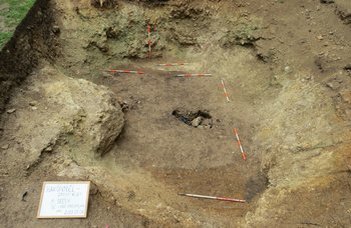In the footsteps of early hermits and medieval monks
The excavations in the Bakonybél Benedictine monastery founded by King Stephen I started in April 2022. The excavations are carried out in the garden of the monastery dedicated to Saint Mauritius within the framework of the research programme ‘Kings – Saints – Monasteries’ supported by the Eötvös Loránd Research Network. The project is implemented by the Research Centre for the Humanities and the work is led by Balázs Szabolcs Nagy, assistant professor at the ELTE Institute of Archaeological Sciences. Technicians experienced in fieldwork, university students, and, in the organisation of the Laczkó Dezső Museum in Veszprém, volunteers are taking part in the work.
In the southern courtyard of the monastery founded in the Middle Ages, archaeologists were able to identify the remains of at least four late medieval constructions, which may have belonged to the southeast quarter of the intricate building complex of the medieval Benedictine abbey. Based on their size, the walls may be suggestive of mostly multi-storey buildings. The pieces of white plaster and the fragments of a window frame carved from stone may indicate residential or farm buildings. The remains of walls with different structures partly intersecting each other represent at least four different periods or phases of construction, which clearly demonstrates the intensive use of the site even before the Ottoman occupation of Hungary.

In addition to various shards of pottery and other small finds, the material culture of the medieval monks is represented by a fifteenth- or sixteenth-century book clasp decorated with a Gothic minuscule. Artefacts connected to pre-medieval habitation include some prehistoric pottery fragments, a Roman coin, a late Avar small belt fitting and several Avar pottery fragments. The results not only brought us closer to identifying the location of the former church and the centre of the monastery but also shed light on many interesting facts unknown before. During the Árpád period, a part of this area was still used as a cemetery, and in the decades of internecine war following the Battle of Mohács, it became necessary to strengthen the building with a timber-framed structure filled with earth.
At the beginning of July, the excavation of the presumed hermit cave at the site called Bakonybél–Szentkút (popularly known as Borostyánkő) was completed. The site is located approx. 1 km south of the monastery. Rising above the man-made pond fed by three springs abundant in water, there is a boulder standing in itself. On the top of the boulder, archaeologists discovered a huge cavity in the rock that is nearly five metres deep. Based on its shape, it must have been dug by humans. The cavity was largely filled with the debris of a demolished medieval chapel. Based on the ruins, researchers could identify the Chapel of the Virgin Mary, known from a written source dated 1230.

Based on the written evidence, archaeologists could also locate the boulder in the medieval topography because the charter refers to the chapel as having stood “above the rock of Saint Gerard”. The name is evidently no coincidence. Later in the modern era, it was also held that the eleventh-century holy hermits Saint Gunther and/or Saint Gerard, who had initiated the foundation of the Benedictine Abbey in Bakonybél, lived there.
The recently excavated cavity in the rock testifies to the special use of space, since the man-made cavity was visibly not allowed to be buried until the Árpád-period chapel existed, the foundation of which was in connection with the early hermits. The excavation material indicates that the chapel built on the boulder and the deep cavity cut in the rock next to it were used simultaneously to promote the local cult of the holy hermit. They were connected to the hermitage and the emergence of the holy place. At the moment, researchers still cannot answer whether the cave was once truly inhabited by hermits.
Source: elte.hu
The cover photograph shows the cavity of the Szentkút Cave at the beginning of the excavation. All photographs were taken by Balázs Szabolcs Nagy.

